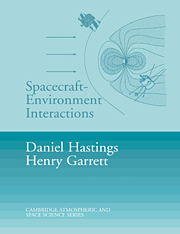Book contents
- Frontmatter
- Contents
- List of Illustrations
- List of Tables
- Preface
- Acknowledgment
- 1 Introduction
- 2 Fundamental Length, Time, and Velocity Scales
- 3 The Ambient Space Environment
- 4 Neutral Gas Interactions
- 5 Plasma Interactions
- 6 The Space Radiation Environment
- 7 Particulate Interactions
- 8 The State of the Art
- References
- Index
1 - Introduction
Published online by Cambridge University Press: 30 September 2009
- Frontmatter
- Contents
- List of Illustrations
- List of Tables
- Preface
- Acknowledgment
- 1 Introduction
- 2 Fundamental Length, Time, and Velocity Scales
- 3 The Ambient Space Environment
- 4 Neutral Gas Interactions
- 5 Plasma Interactions
- 6 The Space Radiation Environment
- 7 Particulate Interactions
- 8 The State of the Art
- References
- Index
Summary
Introduction
Before the space age began, it was realized that space was not empty. Comet tails, meteors, and other extraterrestrial phenomena demonstrated the presence of a “space environment.” Much as an aircraft operates in and interacts with the atmosphere (indeed the air is necessary for lift), so a spacecraft operates in and interacts with this space environment. The environment can, however, limit the operation of the spacecraft and in extreme circumstances lead to its loss. Concern over these adverse environmental effects has created a new technical discipline – spacecraft–environment interactions. The purpose of this text is to describe this new field and introduce the reader to its many different aspects.
Historically, the field of spacecraft–environment interactions has developed primarily as a series of specific engineering responses to each interaction as it was identified. Consider the discovery of the radiation belts and their effects on electronics. This led to the development of radiation shielding and microelectronic-hardening technology. Similarly, in the early seventies, the loss of a spacecraft apparently due to spacecraft charging from the magnetospheric plasma led to intense efforts to understand charge accumulation on surfaces in space and to methods for mitigating the effects. Ultimately, these efforts culminated in the 1979 launch of a dedicated spacecraft, SCATHA (Spacecraft Charging at High Altitudes), into a near geosynchronous orbit for studying this interaction. Likewise, in the eighties, certain materials were found to erode rapidly in the low-Earth space environment because of chemical interactions with atomic oxygen.
- Type
- Chapter
- Information
- Spacecraft-Environment Interactions , pp. 1 - 15Publisher: Cambridge University PressPrint publication year: 1996
- 2
- Cited by



